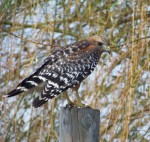
In “How to Really Learn the Birds,” we suggested using the “target method” as a quick way of learning the common birds around you. To use the target method, simply study a bird before going out and searching for it. The key is to study birds you can expect to find in a given season. We’ve got more about common local birds in “How to Really Learn the Birds.”
Though its origins are forests and woodlands, the Red-shouldered Hawk has adapted well to changes in the environment and can even be seen in our urban parks and neighborhoods. Visitors to Modesto’s Thousand Oaks and La Loma Parks often have frequent encounters with this spectacular bird, but seldom get a chance to see it in all its regal beauty. Often, they only get a glimpse as the boldly colored raptor flies by, effortlessly dodging light poles and tree limbs.
The best way to enjoy this hawk’s striking features is to locate one when perched. In open country or along roadsides, they’re frequently perched on telephone wires. In wooded areas, they prefer branches half to three quarters of the way up a tree.
In local parks, Red-shouldered Hawks often announce themselves with a series of high-pitched screams as they fly over a stream or sidewalk. They seldom fly far and can often be visually tracked to a nearby perch.
Once seen closely, the Red-shouldered Hawk’s identity can be confirmed by its rosy breast, black and white upperparts, and black and white banded tail. In flight, the Red-shouldered Hawk has distinctive “windows” in its wings, pale, translucent patches at the base of the flight feathers.
Despite its name, the red shoulders can be hard to see. Many nature lovers have long argued it should be named the “Red-breasted Hawk,” since the rosy breast is so distinctive.
Though it’s one of our most common raptors and can be seen year-round, the Red-shouldered Hawk’s furtive habits make it one of our lesser-known birds. The target method is the key to finding this elusive bird. Once studied closely, it becomes an ever-possible added attraction to any park visit or neighborhood stroll.
